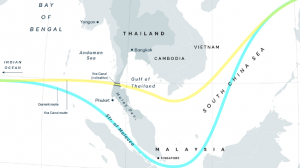ForumIAS announcing GS Foundation Program for UPSC CSE 2025-26 from 19 April. Click Here for more information.
ForumIAS Answer Writing Focus Group (AWFG) for Mains 2024 commencing from 24th June 2024. The Entrance Test for the program will be held on 28th April 2024 at 9 AM. To know more about the program visit: https://forumias.com/blog/awfg2024
Source: The post on Kra Isthmus Project has been created based on the article “Kra, New Delhi’s New KRA” published in “The Times of India” on 2nd December 2023.
UPSC Syllabus Topic: GS paper 2– International relations- Bilateral, regional and global groupings and agreements involving India and/or affecting India’s interests
News: The article discusses Thailand’s plan to build a land bridge in the Kra Isthmus. This bridge could change global trade routes and affect regional powers, especially China and India. It highlights China’s strategic interests and India’s need to respond strategically.
What is the Kra Isthmus Project?
Thailand plans to build a 90-km land bridge (road and rail link) in the Kra Isthmus. It will connect the Andaman Sea and Gulf of Thailand. The project aims to move 20 million TEU (unit of cargo capacity) of containers and cut transport time by 4-6 days.
The bridge could change global shipping routes, reducing reliance on the congested Malacca Strait. This shift might affect major ports in Singapore, Malaysia, and Indonesia.
Source: The maritime executive
Why is China interested in the Kra Isthmus Project?
Overcoming the Malacca Dilemma: This dilemma involves the fear that a blockade of the Malacca Strait by foreign powers, especially the United States, could cripple the Chinese economy.
Expanding Military and Commercial Reach: The project complements China’s broader ambitions in the region, including their military facility in Cambodia. It also aligns with their interests in developing Special Economic Zones (SEZs) near these ports, allowing for easier export to Africa, the Middle East, and Europe.
Enhancing Influence in the Bay of Bengal: China’s increased involvement in the Kra Isthmus region could also lead to a stronger military presence in the Bay of Bengal. This is evident from the potential dual-use capabilities of ports like Hambantota in Sri Lanka and Kyauk Phu in Myanmar.
How does the Kra Isthmus Project impact India?
Geostrategic Concerns: India is wary of the Kra Isthmus Project due to its proximity to the strategic Andaman & Nicobar Islands. This raises concerns about China’s growing influence in the Bay of Bengal, a region of significant importance to India.
Economic Impacts: India’s development plans, like the container trans-shipment port and SEZ at Galathea Bay in Nicobar, might be impacted by Thailand’s similar project in Ranong, which is only 500 nautical miles away.
What should be done by India?
Coordinate with Thailand: Given the proximity of India’s and Thailand’s port projects, closer interaction with the Thai government is essential. India should ensure these projects are complementary, benefiting both countries.
Monitor Chinese Activities: India needs to closely watch China’s involvement in regional ports like Hambantota and Kyauk Phu. This vigilance will help protect India’s commercial interests and prevent a Chinese monopoly in the Bay of Bengal.
Strengthen Regional Ties: India should deepen its engagement with ASEAN countries Myanmar and Bangladesh, focusing on those affected by the Kra Isthmus Project. This helps in understanding and influencing regional dynamics.
Promote Balanced Investment: Encouraging ASEAN’s control over the Kra Isthmus Project and involving other international investors could help maintain a multipolar balance in the region. This approach supports India’s position as a principal maritime power in the Bay of Bengal.
Question for practice:
Examine how the Kra Isthmus Project could impact India’s strategic interests in the Bay of Bengal region?





